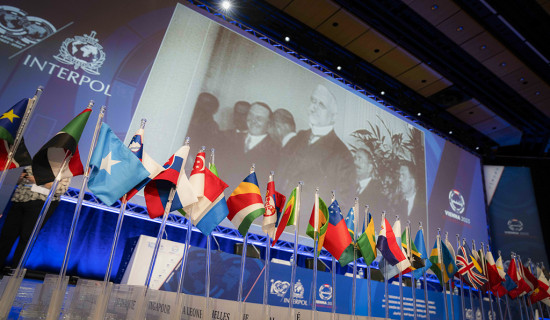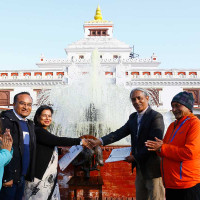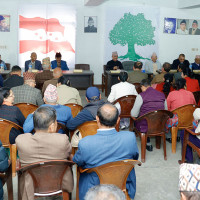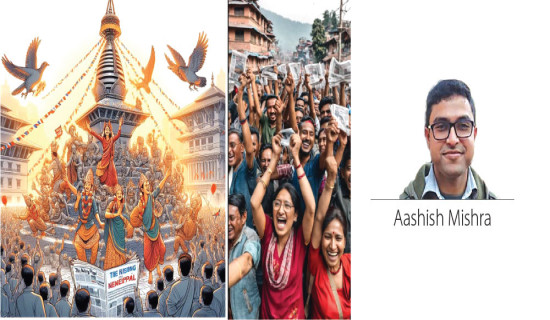- Sunday, 23 November 2025
Daura-Suruwal makes impressive comeback
Kathmandu, Apr. 7: Sagar Basnet, 30, recently experienced what he called a “cultural milestone” when he wore Daura Suruwal for the first time in his life. He donned the attire last month on the occasion of his grandfather’s ceremonial worship at 84 years of age (Chaurasi Puja) and said it felt special.
“My grandfather was very happy to see me in what used to be normal attire for him in his youth. The Daura Suruwal helped connect us in a way,” he said.
Like Basnet, Janak Pradhan, 27, also wore Daura Suruwal for the first time ever last month for a friend’s wedding in Pokhara. However, unlike Basnet, he was initially hesitant, thinking it would not suit him. “I thought a formal suit would be better for the occasion,” he said, admitting that he only wore the dress out of peer pressure.
But after putting it on, he was pleasantly surprised at how comfortable and stylish he felt. “I never thought I would wear Daura Suruwal in my life, but I am glad I did,” he shared. “It was a little outside my comfort zone but I loved how it looked and cannot wait to wear it again.”
Once a ubiquitous part of everyday male clothing, Daura Suruwal, as well as other traditional dresses, fell out of favour over the past half-century. Exposure to global fashion and the availability and affordability of western-style clothing made many Nepalis view the closed-neck top and drawstring trousers as impractical. Its symbolic status as the national dress of the country for men was also removed in 2011 by the Baburam Bhattarai-led government to ‘respect’ the nation’s diversity and the sentiments of various communities.
However, in 2018, the Ministry of Home Affairs made Daura Suruwal the ‘official attire’ for formal functions along with the dresses worn by people from different geographical regions, cultures and religions which reflect their traditions and identity.
In 2019, Bhattarai himself was seen dressed in Daura Suruwal in a picture he tweeted when entering Karnali Province. “Garb in line with the land. Entered the Khas-majority Karnali Province, dressed in Daura Suruwal for the first time in my life!” read the caption.
Prime Minister Pushpa Kamal Dahal ‘Prachanda’ also made news when he was seen in Daura Suruwal during his swearing-in ceremony on December 26, last year. He had never worn the dress in a public capacity before that, not even during his two previous tenures as the head of the country’s government.
“There has been a noticeable rise in interest in Daura Suruwal and ethnic dresses over the past few years,” informed Rajendra Kumar Rai, owner of Om Collection, a clothing rental business based in Putalisadak, Kathmandu.
“From parties to school and college events to formal, official programmes, people are choosing to dress up in Daura Suruwal rather than other western clothes.”
Bibek Bajracharya, proprietor of Nepali Daura Suruwal Tailors, Bhedasingh, Kathmandu, said that Daura Suruwal had become the preferred habiliment for parties. Asked why, he said that it may be because it was cheaper than suits. “Good suits can cost upwards of Rs. 10,000 while a great Daura Suruwal set can be purchased for just Rs. 2,200.”
Rai felt that it was because it gave the wearer a distinct Nepali look.
But, Bhuwan Maharjan, a retired tailor from Bhaktapur, said that the resurgence was due to novelty.
“Daura Suruwal has become new again. That’s why people want it,” felt Maharjan, who used to sew Nepali, Indian and Western clothes up until a decade ago. “Up until the early 1970s, Daura Suruwal was everywhere so no one valued it. We went after tucked-in shirts, neckties and ironed coats because they seemed exotic and attractive. Now, suits are omnipresent and Daura Suruwal is not. Thus, those who wear it appear distinct and stand out from the crowd. So, people like it again.”
History of Daura Suruwal
Daura Suruwal consists of two pieces of garments. The Daura is the upper wear, a closed-neck shirt with eight strings that serve to tie it around the body, and the Suruwal is the pair of trousers. The coat that people wear over the Daura is a recent addition, considered to have been introduced by the first Rana Prime Minister Jung Bahadur Rana after he was gifted an English jacket during his tour of the United Kingdom in 1850. As part of the set, people also wear a black ‘Bhadgaunle’ cap or a Dhaka topi on their heads.
Daura Suruwal bears a resemblance to the Tapaalan, the traditional clothing of Newa men, and includes components found in the indigenous attire of other communities across the hills of Nepal too. The word ‘Daura’ is believed to have originated from the word ‘Drapi’, mentioned in the ancient Sanskrit texts Rig Veda and Atharva Veda as meaning a masculine mantle or garment.
According to Professor Dr. Purushottam Lochan Shrestha, former head of the Department of History, Anthropology and Sociology at Tribhuvan University, the Daura also represents a protective shield wrapped around one’s body. “Its eight strings represent the eight mother goddesses – the Astamatrika.”
Dr. Shrestha informed that this was a product of the traditions developed to worship and show devotion to female energies (Shakti) in the mediaeval age. “It was a time of warfare and so, people worshipped fierce female divinities to gain power [for attacks] and protection [from attacks]. This influenced the attire too.”
He further stated that the present-day Daura Suruwal was a modified form of the vestment Jama still worn by Newa priests as well as the shamans in Nuwakot and adherents of the Masto culture in western Nepal. “The statue of King Jayavarma kept at the National Museum in Chhauni, Kathmandu, shows the original form of this garb,” he informed.
The statue bears the date Saka Samvat 107 (185 AD) and is considered the oldest sandstone sculpture in Nepal.






-original-thumb.jpg)






